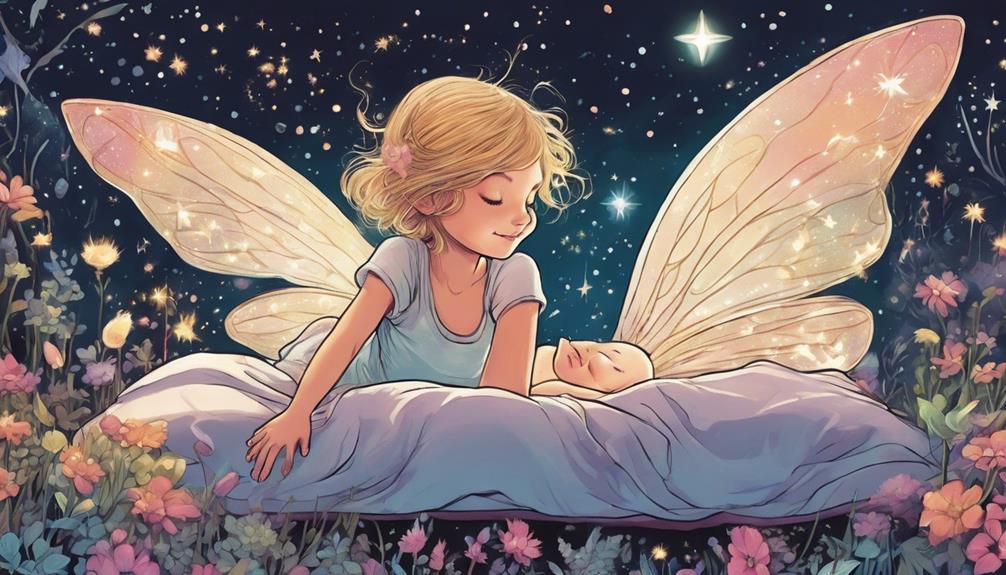The Tooth Fairy's world is filled with surprising allies that keep the magic alive. You might not expect to find mice like La Petite Souris in France or Ratoncito Pérez in Spain helping her collect teeth. In Brazil, birds swoop in to gather thrown teeth, while lizards lend a hand in African cultures. Each tradition emphasizes joy and hope during this important childhood rite of passage. The Tooth Fairy, backed by these unique helpers, reinforces the significance of dental health and connection to nature. Curious about more surprising traditions and allies? You're in for a treat!
Key Takeaways
- The Tooth Fairy partners with animal allies like mice in France and Spain, symbolizing childhood innocence and magic.
- In Brazil, children toss teeth outside for birds, celebrating dental health and connecting with nature.
- Indian customs involve placing teeth on rooftops for sparrows, representing hope for new growth and healthy teeth.
- African cultures feature lizards that collect teeth, showcasing diverse beliefs about strength and future growth.
Unlikely Partnerships

The Tooth Fairy's enchanting world thrives on unlikely partnerships with various animal allies, each adding a unique twist to the age-old tradition of tooth exchange. From the clever raccoon who sneaks into children’s rooms to retrieve lost teeth, to the industrious ants who help build the Tooth Fairy’s magical kingdom, each animal brings its own special talents to the tooth collecting process. The tooth fairy’s unique friendships with these creatures also provide valuable lessons about cooperation and friendship, proving that even the most unexpected partnerships can lead to magical results. The Tooth Fairy’s enchanted world is a testament to the power of teamwork and the importance of embracing diversity.
In France and Spain, for instance, you'll find that little mice, known as La Petite Souris and Ratoncito Pérez, play essential roles in gathering children's lost teeth. These charming animal helpers not only assist the Tooth Fairy but also bring a sense of magic to the experience.
In Brazil, children toss their teeth outside for birds to collect, showcasing a beautiful bond between nature and tooth traditions. Here, birds are believed to exchange teeth for gifts, reinforcing the idea that tooth loss is a cause for celebration.
Similarly, in some African cultures, lizards become involved when kids throw teeth onto roofs, as these creatures are thought to help guarantee strong new teeth grow in.
These partnerships highlight the importance of animal helpers in the mythos surrounding the Tooth Fairy. They symbolize hope and childhood innocence, reminding us all to maintain our belief in magical figures and the enchanting stories that accompany them.
Global Tooth Traditions

Exploring global tooth traditions reveals a fascinating array of customs, each reflecting unique cultural beliefs and practices surrounding the loss of children's teeth.
In France, instead of a fairy, kids leave their baby teeth for La Petite Souris, a little mouse that exchanges them for money or gifts. This charming tradition showcases how different cultures personalize the experience of losing teeth.
In Spain, Ratoncito Pérez serves a similar role, collecting baby teeth and reinforcing the idea of animal helpers. Meanwhile, Brazilian children toss their lost teeth outside for birds to gather, symbolizing a connection to nature and reinforcing hope for strong future teeth. In India, kids place their teeth on rooftops, inviting sparrows to take them, echoing that same sense of hope and nature.
Several African cultures add their unique spin, as children often throw their top teeth onto roofs while burying their bottom teeth. These diverse customs highlight the rich tapestry of beliefs surrounding tooth loss, demonstrating that whether it's a fairy, a mouse, or nature itself, many support kids during this milestone.
Animal Allies

Animal helpers play a magical role in tooth traditions, as seen with mice, birds, and even lizards, each adding a unique twist to the experience of losing a tooth. In countries like France and Spain, children look forward to La Petite Souris and Ratoncito Pérez, tiny mice that collect their lost teeth and leave behind delightful treats.
Meanwhile, in Brazil, kids toss their teeth outside for birds, a symbolic gesture where only healthy teeth are taken, reinforcing the idea of a gift exchange.
In some African cultures, lizards assist in finding lost teeth. Children throw their teeth onto roofs, attracting these creatures and inviting a connection with nature. In India, sparrows play a significant role, as children place their teeth on rooftops, hoping for new ones to grow, guided by the birds.
These animal allies enhance the enchanting experience surrounding tooth loss, intertwining nature with the magical fairy's world. By embracing these traditions, you're not just participating in a fun ritual, but also celebrating the bond between childhood, nature, and the whimsical aspects of growing up.
Unique Customs

Unique customs surrounding tooth loss vary widely across cultures, each adding its own charm and significance to the experience.
In Brazil, you might toss your lost teeth outside for birds, believing only healthy teeth will earn you gifts. Meanwhile, in India, placing lost teeth on rooftops for sparrows symbolizes hope for new teeth and a connection to nature.
In many African cultures, children throw their lost teeth onto roofs, with unique practices distinguishing between top and bottom teeth, showcasing the diversity of oral traditions.
If you were in France, you'd be visited by La Petite Souris, a mouse that collects teeth and leaves money or candy, highlighting another cultural twist on the tooth fairy concept.
Throughout Latin America, Ratoncito Pérez takes center stage, retrieving children's teeth from various locations, reinforcing the importance of tooth loss celebrations.
These unique customs surrounding tooth loss not only reflect different beliefs but also emphasize the universal joy and excitement that comes with losing a tooth, with tooth fairies and their counterparts playing an essential role in making this change memorable.
The Role of Guardians

Guardians play an essential role in preserving the magic of childhood, guaranteeing that children hold onto their sense of wonder and belief in the extraordinary. Among them, the Tooth Fairy, known as Toothiana, stands out with her unique responsibilities. She commands a group of Mini-Fairies, each playing a crucial part in collecting teeth and safeguarding the precious memories tied to them.
These Guardians unite to combat the fears instilled by Pitch Black, the Boogeyman, who threatens to diminish children's belief in magic. Recognizing their importance, you can appreciate how they work tirelessly to protect that fragile belief.
Consider the emotions they evoke in children:
- Joy of losing a tooth and finding a surprise
- Comfort in knowing someone cares for their lost treasures
- Excitement every time they anticipate the Tooth Fairy's visit
Each Guardian's strength is fueled by these beliefs, emphasizing how crucial it's for you to nurture hope and imagination in children.
Cultural Significance

The Tooth Fairy's role in celebrating tooth loss rituals highlights the cultural significance these traditions hold across various societies. When you think about losing a tooth, you might imagine the excitement of placing it under your pillow, but this experience varies widely around the world.
In France, for example, La Petite Souris takes the place of the Tooth Fairy, while in Spain, children look for Ratoncito Pérez. These figures reflect each culture's unique approach to celebrating milestones in childhood.
In Brazil, children toss their lost teeth outside for birds, showcasing a connection to nature and emphasizing the value of healthy teeth. African customs, such as throwing teeth onto roofs or burying them, reveal diverse beliefs about strength and future growth.
The evolution of the Tooth Fairy in Western culture represents a shift towards a more whimsical and magical childhood experience.
Ultimately, the cultural significance of these dental traditions underscores their role in marking important moments in kids' lives. They offer not just a fun story, but also a sense of belonging and understanding as children navigate the journey of growing up.
Importance of Community

Recognizing the importance of community, you'll find that traditions surrounding the Tooth Fairy thrive through the collective efforts of parents, caregivers, and local customs. Community involvement fuels the magic of tooth loss, ensuring that children experience wonder and joy during this significant milestone.
Shared storytelling creates a sense of belonging and connection among families.
Local customs, like tossing teeth for birds, foster a magical environment that sparks imagination.
Collective celebrations of growth help children understand the importance of each tooth lost.
Educators and caregivers work together to instill positive dental habits alongside these enchanting traditions.
These shared experiences not only enrich children's lives but also strengthen community bonds.
When families engage in these traditions, they cultivate a supportive network that celebrates milestones and nurtures healthy habits.
The smiles that accompany the Tooth Fairy's visits reflect the collective joy of a community working together.
As you participate in these rituals, you're not just upholding a tradition; you're contributing to a rich tapestry of community involvement that helps children embrace change with excitement and wonder.
Celebrating Tooth Loss

Celebrating tooth loss is a joyful tradition that marks a significant milestone in childhood, transforming what could be an intimidating experience into a fun and exciting event. When your child loses a tooth, they might enthusiastically anticipate the arrival of the Tooth Fairy, who leaves behind money or small gifts. This exchange reinforces the importance of this rite of passage, making it a memorable moment.
Across the globe, different cultures find unique ways to celebrate tooth loss. In Brazil, children toss their lost teeth outside for birds, symbolizing a connection to nature. Meanwhile, in Spain, Ratoncito Pérez plays a similar role to the Tooth Fairy, leaving gifts in exchange for lost teeth.
These customs highlight how celebrating tooth loss can alleviate fears and anxieties about growing up.
Frequently Asked Questions
What Does Ratoncito Perez Do With the Teeth?
Ratoncito Pérez collects your lost teeth, leaving gifts in return. He uses those teeth to build his magical castle or create special items, celebrating childhood memories while helping you shift into adulthood. Isn't that enchanting?
Who Are the Tooth Fairies' Friends?
The Tooth Fairy's friends include Mini-Fairies who help her collect teeth, animal helpers like La Petite Souris in France, and fellow Guardians such as Jack Frost, all supporting her magical mission in various ways.
Who Is the Tooth Fairy in Rise of the Guardians Va?
In "Rise of the Guardians," the Tooth Fairy is voiced by Isla Fisher. You'll find her character vibrant and nurturing, embodying a blend of whimsy and strength as she protects children's memories and innocence.
What Is the Real Story of the Tooth Fairy?
You might think the Tooth Fairy's just a simple myth, but her story weaves through time, blending traditions of mice, magic, and childhood rites, symbolizing growth and the excitement of losing your first teeth.
Conclusion
In the whimsical world of tooth loss, you've just discovered that the Tooth Fairy isn't flying solo!
With a quirky squad of animal allies, global traditions, and supportive guardians, she's got the ultimate dream team.
Imagine a raccoon in a tutu and a wise old owl plotting the next tooth heist!
Together, they transform a simple rite of passage into a festival of joy.
So, next time a tooth wiggles, remember: you're part of this magical, toothy alliance!









